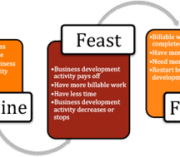Nine Ways You’re Losing Business (part 8)
Welcome to part 8 of a 10-part series, Nine Ways You’re Losing Business—and What to Do About It.
Reason No. 7: You “don’t have time.”
Time. That great limiter for every practice. No one has time enough for everything We know this. And yet, some days, doesn’t it feel like you could summarize your task list by writing simply, “EVERYTHING”? You have billable work, admin work, plus a personal life, and you want to add more on top of that?
If you don’t make time to complete business development activities and to create value for your clients, you’re losing business.
The “more” you have to add to your task list includes activity designed to raise your profile in the marketplace, client acquisition, and creating value for your clients above and beyond the billable work you do for them. You might group all of this as business development activity, since it’s designed to bring in and satisfy your clientele. That seems like a tall order, and in some ways it is, but two operating principles can simplify it a bit.
First, you have to find a way to marry your business development work with your billable work. When the two are divorced, as they generally are, you’ll have the sense that you can do only one of those activities, and the billable work will win. That’s how the feast/famine cycle gets started.
When your business development work comes from and through your billable work, you’ll exit the feast/famine cycle. For example, you might find ideas for writing or speaking based on the questions your clients raise, and you might even be able to develop a client memorandum into an article by replacing the elements specific to the client with a fictionalized or generalized description and making some general suggestions based on your discussion and analysis of the issue. You may also ask your clients for referrals and introductions, and inviting current and former clients for a presentation or program that interests them may turn into a quite effective business development activity.
You will need to supplement your business development efforts with activity that is truly separate from your billable work, of course, but when there’s significant overlap between the two aspects of practice maintenance and growth, you’ll make better use of your time. The separate work might include activities such as networking, working within an industry organization, or serving on a board of directors. You will find some nexus between those activities and your practice (otherwise, the activities would not be well-suited to help build your practice), but there’s an unavoidable separation between those activities and your billable work.
The second approach, which must work in tandem with the first, requires you to prioritize everything that you do. Is business development a priority for you? Here, it’s important that you have a business development plan that’s broken down into projects (raising your profile, meeting new referral sources) and tasks (writing an article or a blog post, identifying an organization populated by those who do business with or otherwise influence your clients) so that you have specific action items to prioritize. Trying to prioritize categories of tasks like billable work and business development will be ineffective because you’ll never be able to check either off your task list. But you can check off “Draft Smith MSJ brief” or “Attend IEEE meeting,” and you can prioritize each action based on its urgency and its importance.
Brian Andreas, the artist who creates StoryPeople, sums it up this way: “Everything changed the day I figured out there was exactly enough time for the important things in my life.” When you recognize the essential truth there, you’ll see that the key is to decide what’s important. In other words, is it important for you to meet contacts who could refer new business to you? If so, how can you fit that into your schedule?
Don’t misunderstand this approach as a “woowoo” nice but meaningless idea. While you will have days in which you actually can’t squeeze everything that’s important to you, if you think about what is important—meeting deadlines, returning client calls, eating, sleeping—you’ll find that you generally fit at least some of each important activity into your days over the course of a week.
Which activities are important will vary from day to day, but when it comes to business development activity, you’ll want to be sure that you are active in each of these areas each week or month:
Take a few minutes to examine your task list. (Don’t have one? Create it right now.) Strike anything on your list that is not important. Next, look for ways to incorporate business development activity into your billable work. Add to your list any business development tasks that are important for you and not otherwise included. Each evening, block time for the next day’s tasks, leaving a few blocks of time open for unexpected tasks that need urgent attention. Finally, look at your task list and your calendar, and be sure that you’re incorporating each aspect of business development activity over the course of a month.
If you don’t make the time for client value creation and business development activity on a regular and consistent basis, you’re losing business.




Leave a Reply
Want to join the discussion?Feel free to contribute!